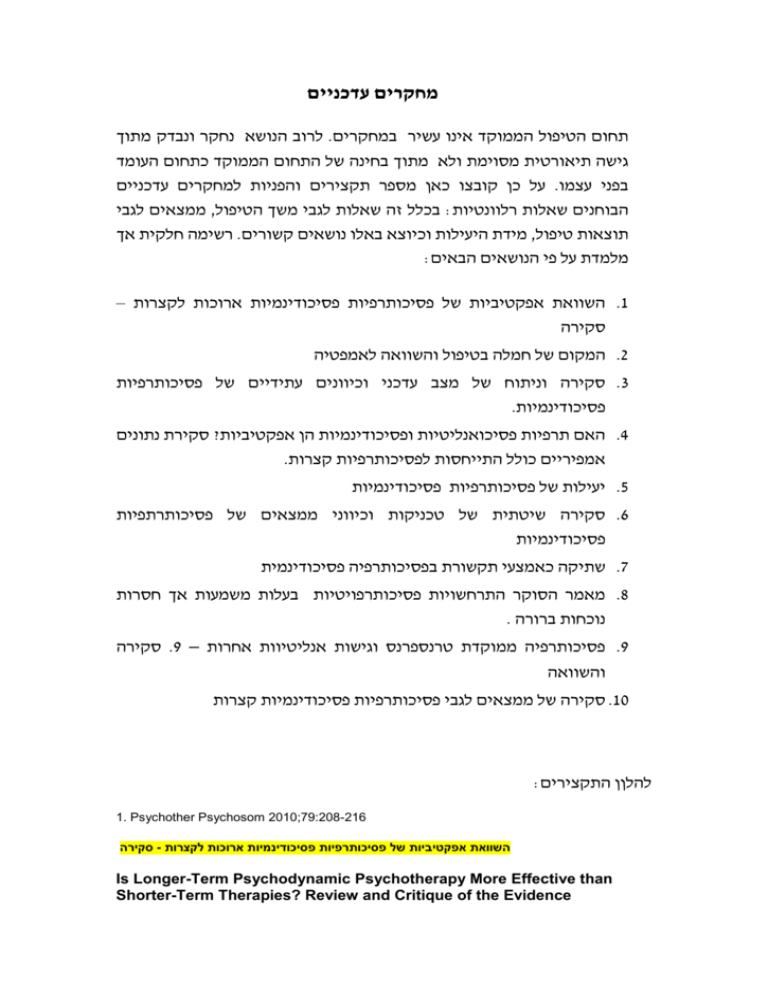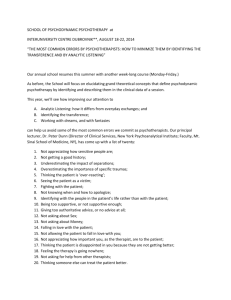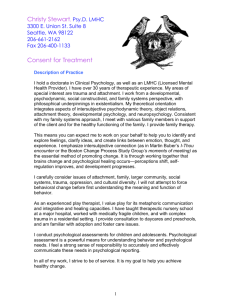
מחקרים עדכניים
תחום הטיפול הממוקד אינו עשיר במחקרים .לרוב הנושא נחקר ונבדק מתוך
גישה תיאורטית מסוימת ולא מתוך בחינה של התחום הממוקד כתחום העומד
בפני עצמו .על כן קובצו כאן מספר תקצירים והפניות למחקרים עדכניים
הבוחנים שאלות רלוונטיות :בכלל זה שאלות לגבי משך הטיפול ,ממצאים לגבי
תוצאות טיפול ,מידת היעילות וכיוצא באלו נושאים קשורים .רשימה חלקית אך
מלמדת על פי הנושאים הבאים:
.1השוואת אפקטיביות של פסיכותרפיות פסיכודינמיות ארוכות לקצרות –
סקירה
.2המקום של חמלה בטיפול והשוואה לאמפטיה
.3סקירה וניתוח של מצב עדכני וכיוונים עתידיים של פסיכותרפיות
פסיכודינמיות.
.4האם תרפיות פסיכואנליטיות ופסיכודינמיות הן אפקטיביות? סקירת נתונים
אמפיריים כולל התייחסות לפסיכותרפיות קצרות.
.5יעילות של פסיכותרפיות פסיכודינמיות
.6סקירה שיטתית של טכניקות וכיווני ממצאים של פסיכותרתפיות
פסיכודינמיות
.7שתיקה כאמצעי תקשורת בפסיכותרפיה פסיכודינמית
.8מאמר הסוקר התרחשויות פסיכותרפויטיות בעלות משמעות אך חסרות
נוכחות ברורה .
.9פסיכותרפיה ממוקדת טרנספרנס וגישות אנליטיוות אחרות – .9סקירה
והשוואה
.11סקירה של ממצאים לגבי פסיכותרפיות פסיכודינמיות קצרות
להלןן התקצירים:
1. Psychother Psychosom 2010;79:208-216
השוואת אפקטיביות של פסיכותרפיות פסיכודינמיות ארוכות לקצרות -סקירה
Is Longer-Term Psychodynamic Psychotherapy More Effective than
Shorter-Term Therapies? Review and Critique of the Evidence
Sunil S. Bhara, Brett D. Thombsb, Monica Pignottic, Marielle Basselb, Lisa Jewettb, James C.
Coyned, Aaron T. Beckd
Abstract
Background: In 2008, Leichsenring and Rabung performed a meta-analysis of 8 studies of
longer-term psychodynamic psychotherapy (LTPP). The work was published in the Journal of
the American Medical Association (vol. 300, pp 1551–1565), and they concluded that LTPP
was more effective than shorter-term therapies. Method: Given that such claims have the
potential to influence treatment decisions and policies, we re-examined the meta-analysis and
the 8 studies. Results: We found a miscalculation of the effect sizes used to make key
comparisons. Claims for the effectiveness of LTPP depended on a set of small,
underpowered studies that were highly heterogeneous in terms of patients treated,
interventions, comparison-control groups, and outcomes. LTPP was compared to 12 types of
comparison-controls, including control groups that did not involve any psychotherapy, shortterm psychodynamic psychotherapy, and unvalidated treatments. Additionally, the studies
failed to protect against threats to bias, and had poor internal validity. Conclusion: Overall, we
found no evidence to support claims of superiority of LTPP over shorter-term methods of
psychotherapy.
2. Psychother Res. 2009 Mar;19(2):157-71.
Compassion in psychotherapy: the perspective of therapists
nominated as compassionate.
Vivino BL, Thompson BJ, Hill CE, Ladany N.
Independent Practice, Berkeley, CA 94707, USA. BVivino@aol.com
.המקום של חמלה בטיפול והשוואה לאמפטיה
Abstract
Fourteen therapists nominated by peers as compassionate defined compassion in psychotherapy as
connecting with the client's suffering and promoting change through action. They indicated that
compassion was broader and deeper than empathy, helps clients feel understood, and relieves
symptoms. Although indicating that compassion was innate, therapists felt it could be further awakened.
Factors facilitating compassion in therapy were therapists feeling clients' suffering, understanding client
dynamics, identifying with and liking clients, client involvement, and a good therapy relationship.
Hindering factors included clients being resistant, being aggressive, having serious pathology, or
violating boundaries; therapists having interfering personal issues, feeling incompetent, or having
negative reactions to or not liking clients; and a poor therapy relationship. A theory regarding
compassion in psychotherapy is proposed.
PMID: 19034730 [PubMed - indexed for MEDLINE]
3. Psychiatry. 2010 Spring;73(1):43-56.
The future of psychodynamic psychotherapy.
.סקירה וניתוח של מצב עדכני וכיוונים עתידיים של פסיכותרפיות פסיכודינמיות
Cortina M.
Attachment and Human Development Center, Washington School of Psychiatry, Institute of
Contemporary Psychotherapy and Psychoanalysis, Washington, DC, USA.
mauriciocortina@starpower.net
Abstract
The article reviews the current state and future of psychodynamic psychotherapies. In the past few
decades psychodynamic psychotherapies have fallen into disrepute due to the fractious and dogmatic
nature of different psychodynamic schools of thought and the lack of interest in validating some of its
major premises or its effectiveness in comparison with other psychotherapy modalities. Despite these
self-inflicted wounds, psychodynamic theory and treatment is staging a comeback. Many of the major
premises that comprise the complex, layered model of the mind that are the basis of psychodynamic
treatments have again begun to be validated. A list of basic psychodynamic concepts is described. The
evidence for each of these concepts varies, but as a whole the evidence is broad and deep for the
model of the mind posited by psychoanalysis. This evidence is coming from many fields of knowledge
that are not necessarily influenced by psychoanalysis. There have also been significant advances in
developing methods and tools that can probe systematically into the complex nature of psychodynamic
treatment processes. Finally, statistical tools-such as meta-analytic studies-that can aggregate and
compare many different studies at once are beginning to show the effectiveness of dynamic
psychotherapies in comparison with other modalities of treatment.
4. Int J Psychoanal. 2005 Jun;86(Pt 3):841-68.
Are psychodynamic and psychoanalytic therapies effective?: A
review of empirical data.
האם תרפיות פסיכואנליטיות ופסיכודינמיות הן אפקטיביות? סקירת נתונים
.אמפיריים כולל התייחסות לפסיכותרפיות קצרות
Leichsenring F.
Clinic of Tiefenbrunn and University of Gottingen, von Sieboldstr 5, D-37075, Gottingen, Germany.
fleichs@gwdg.de
Abstract
There is a need for empirical outcome research in psychodynamic and psychoanalytic therapy.
However, both the approach of empirically supported therapies (EST) and the procedures of evidencebased medicine (EBM) have severe limitations making randomised controlled trials (RCTs) an absolute
standard. After a critical discussion of this approach, the author reviews the empirical evidence for the
efficacy of psychodynamic psychotherapy in specific psychiatric disorders. The review aims to identify
for which psychiatric disorders RCTs of specific models of psychodynamic psychotherapy are available
and for which they are lacking, thus providing a basis for planning further research. In addition, results of
process research of psychodynamic psychotherapy are presented. As the methodology of RCTs is not
appropriate for psychoanalytic therapy, effectiveness studies of psychoanalytic therapy are reviewed as
well. Studies of psychodynamic psychotherapy published between 1960 and 2004 were identified by a
computerised search using Medline, PsycINFO and Current Contents. In addition, textbooks and journal
articles were used. Twenty-two RCTs were identified of which 64% had not been included in the 1998
report by Chambless and Hollon. According to the results, for the following psychiatric disorders at least
one RCT providing evidence for the efficacy of psychodynamic psychotherapy was identified:
depressive disorders (4 RCTs), anxiety disorders (1 RCT), post-traumatic stress disorder (1 RCT),
somatoform disorder (4 RCTs), bulimia nervosa (3 RCTs), anorexia nervosa (2 RCTs), borderline
personality disorder (2 RCTs), Cluster C personality disorder (1 RCT), and substance-related disorders
(4 RCTs). According to results of process research, outcome in psychodynamic psychotherapy is
related to the competent delivery of therapeutic techniques and to the development of a therapeutic
alliance. With regard to psychoanalytic therapy, controlled quasi-experimental effectiveness studies
provide evidence that psychoanalytic therapy is (1) more effective than no treatment or treatment as
usual, and (2) more effective than shorter forms of psychodynamic therapy. Conclusions are drawn for
future research.
5. Am Psychol. 2010 Feb-Mar;65(2):98-109.
The efficacy of psychodynamic psychotherapy.
יעילות של פסיכותרפיות פסיכודינמיות
Shedler J.
University of Colorado Denver School of Medicine, Aurora, 80045, USA. jonathan@shedler.com
Abstract
Empirical evidence supports the efficacy of psychodynamic therapy. Effect sizes for psychodynamic
therapy are as large as those reported for other therapies that have been actively promoted as
"empirically supported" and "evidence based." In addition, patients who receive psychodynamic therapy
maintain therapeutic gains and appear to continue to improve after treatment ends. Finally,
nonpsychodynamic therapies may be effective in part because the more skilled practitioners utilize
techniques that have long been central to psychodynamic theory and practice. The perception that
psychodynamic approaches lack empirical support does not accord with available scientific evidence
and may reflect selective dissemination of research findings. 2009 APA, all rights reserved.
6. Psychol Psychother. 2007 Jun;80(Pt 2):217-28.
Psychodynamic psychotherapy: a systematic review of techniques,
indications and empirical evidence.
סקירה שיטתית של טכניקות וכיווני ממצאים של פסיכותרתפיות פסיכודינמיות
Leichsenring F, Leibing E.
Clinic of Psychosomatics and Psychotherapy, University of Goettingen, Goettingen, Germany.
fleichs@gwgd.de
Abstract
PURPOSE: Psychodynamic psychotherapy is one of the most frequently applied methods of
psychotherapy in clinical practice. However, it is the subject of controversial discussion, especially with
regard to empirical evidence. In this article we aim to give an up-to-date description of the treatment and
to review the available empirical evidence. Evidence is reviewed for both efficacy and mechanisms of
change of short- and moderate-term psychodynamic psychotherapy. Furthermore, results of
effectiveness studies of long-term psychoanalytic therapy are reviewed. METHODS: With regard to
efficacy, a protocol for a Cochrane review for (short-term) psychodynamic psychotherapy is available
specifying inclusion criteria for efficacy studies. RESULTS: Twenty-three randomized controlled trials of
manual-guided psychodynamic psychotherapy applied in specific psychiatric disorders provided
evidence that psychodynamic psychotherapy is superior to control conditions (treatment-as-usual or wait
list) and, on the whole, as effective as already established treatments (e.g. cognitive-behavioural
therapy) in specific psychiatric disorders. With regard to process research, central assumptions of
psychodynamic psychotherapy were confirmed by empirical studies. CONCLUSIONS: Further research
should include both efficacy studies (on specific forms of psychodynamic psychotherapy in specific
mental disorders) and effectiveness studies complementing the results from experimental research
settings. Future process research should address the complex interactions among interventions,
patient's level of functioning, helping alliance and outcome.
7. Clin Psychol Rev. 2002 Sep;22(7):1091-104.
Silence as communication in psychodynamic psychotherapy.
שתיקה כאמצעי תקשורת בפסיכותרפיה פסיכודינמית
Lane RC, Koetting MG, Bishop J.
Nova Southeastern University, Center for Psychological Studies, 3310 College Avenue, Ft. Lauderdale,
FL 33314-7796, USA. boblane@cps.nova.edu
Abstract
Moments of silence in the therapy hour, on the part of the client or therapist, can communicate important
psychodynamic information, as well as deeply facilitate the therapeutic encounter. The client may be
communicating emotional and relational messages of need and meaning. The therapist can use silence
to communicate safety, understanding and containment. However, if this intervention is not skillfully and
sensitively employed by the practitioner, the client may feel the therapist's quietness as distance,
disinterest, and disengagement, leading to breaches in the trust and safety of the therapeutic alliance
8. Ann Fam Med. 2009 Jan-Feb;7(1):80-3.
Something in nothing: negative space in the clinician-patient
relationship.
מאמר הסוקר התרחשויות פסיכותרפויטיות בעלות משמעות אך חסרות נוכחות
. ברורה
Buetow SA.
Department of General Practice and Primary Health Care, University of Auckland, Auckland, New
Zealand. s.buetow@auckland.ac.nz
Abstract
Clinicians can easily miss the importance of how what is not present gives depth, perspective, and clues
to the real meaning of social action in clinical encounters. This essay addresses examples of commonly
overlooked forms of this concept of negative space in the clinician-patient relationship. The examples
are negative physical space, which denotes the physical distances that separate clinicians and patients
during face-to-face encounters; negative communicative space, which refers to how nonverbal and
verbal communication can signify information not exchanged during these visits; and negative
longitudinal space, which describes pauses over time and includes what is not said between clinicians
and patients between visits. Discussed is how the awareness of these different spaces helps us to let go
of our preconceptions, to experience what is there rather than what we expect to find, and to use space
sensitively to improve interactions with patients.
9. Int J Psychoanal. 2008 Jun;89(3):601-20.
Transference focused psychotherapy: overview and update.
פסיכותרפיה ממוקדת טרנספרנס אנליטיוות אחרות – סקירה והשוואה לשיטות
.אנליטיות ולא אנליטיות
Kernberg OF, Yeomans FE, Clarkin JF, Levy KN.
New York Presbyterian Hospital, 21 Bloomingdale Road, White Plains, New York 10605, USA.
okernber@med.cornell.edu
Abstract
This paper describes a specific psychoanalytic psychotherapy for patients with severe personality
disorders, its technical approach and specific research projects establishing empirical evidence
supporting its efficacy. This treatment derives from the findings of the Menninger Foundation
Psychotherapy Research project, and applies a model of contemporary psychoanalytic object relations
theory as its theoretical foundation. The paper differentiates this treatment from alternative
psychoanalytic approaches, including other types of psychoanalytic psychotherapy as well as standard
psychoanalysis, and from three alternative non-analytical treatments prevalent in the treatment of
borderline patients, namely, dialectic behavior therapy, supportive psychotherapy based on
psychoanalytic theory, and schema focused therapy. It concludes with indications and contraindications
to this particular therapeutic approach derived from the clinical experience that evolved in the course of
the sequence of research projects leading to the empirical establishment of its efficacy.
10 . Short-term psychodynamic psychotherapy:
review
of recent process and outcome studies
סקירה של ממצאים לגבי פסיכותרפיות פסיכודינמיות קצרות
Andrew J. Lewis, Michelle Dennerstein, Petah M. Gibbs
Short-term psychodynamic psychotherapy (STPP) is a widely practised form of
psychological intervention. Given that the Roth and Fonagy (1996) review concluded
that there was a lack of confirming evidence for STPP, the current review is focused on
studies published between 1996 and 2006 that evaluate the efficacy of STPP. As a result
of a systematic literature review, 18 studies were found that met inclusion criteria
consistent with those used by Roth and Fonagy (1996) for selection of studies, patient
groupings and definition of therapeutic method. In general these studies add to an
increasing body of evidence suggesting that STPP can be an effective psychological
treatment for individuals experiencing mental health problems. Specifically, for
depression STPP can be equal in effects to other psychological treatments and is
significantly better than no treatment in the short term. Furthermore, emerging process
data indicate that there is a significant relationship between the use of specific
psychodynamic therapeutic techniques and the alleviation of depressive symptoms.
Increasing evidence has emerged to support STPP as a treatment for generalized
anxiety disorder, panic disorder and some personality disorders. There remains limited
evidence for the use of STPP treatment for patients with anxiety disorders that relate
more to stress. Very limited and inconclusive evidence currently exists to support STPP
as a treatment for bipolar disorder, eating disorders and drug dependency. Future
research needs to include broader assessment measures, long-term follow up, studies
that maintain an identifiable focus, and research that includes a focus on psychotherapy
process variables as they interact with outcomes.
Key words: outcome assessment (health care), psychodynamic therapy, short-term
psychotherapy.
Australian and New Zealand Journal of Psychiatry 2008; 42:445
_
455





![UW2 - Psychiatric Treatments [2014]](http://s3.studylib.net/store/data/006859622_1-db6167287f6c6867e59a56494e37a7e7-300x300.png)


